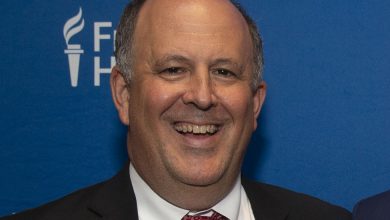A 12-Hour Race to Salute British Vets

TY CROES, Wales — Tucked away in the breast pocket of Wales is a racing circuit called Anglesey. Anyone who has been to Wales will already know that if you walk in any direction for more than 10 seconds, you’ll find yourself going either up- or downhill, and this track on Anglesey Island is the same. In the background, the Irish Sea crashes up over the rocks just meters from the action.
Anglesey, a course that already oozes atmosphere, recently played host to one of the most emotional races on any four-wheeled calendar. The Mission Motorsport Race of Remembrance is a 12-hour endurance race — as well as a celebration of human endeavor, speed and the military mind-set.

Spectators watching the race, with a view across the sea to Snowdonia.Credit…Ben Quinton for The New York Times
Mission Motorsport is a charity that uses the sport to help military veterans race, recover and retrain, allowing them to integrate into jobs in the automotive industry. Among its beneficiaries are veterans who are missing limbs or struggling with their mental health. What joins them together is a passion for petrol and the pursuit of speed. The Race of Remembrance allows them to celebrate that, and it shines a spotlight on the charity’s good work.
This year I was fortunate to join a team and race. (I should qualify my experience at racing cars: none whatsoever. I’m a motorcycle journalist by trade and as a father of four I drive a dad wagon that is about as far as you can get from the adapted Morgan Plus Four that we’ll be racing.)
Before I became a journalist, I was a soldier in the British Army for 10 years. I served in the Royal Engineers on operational tours in Bosnia and Iraq, all the while daydreaming about cars, bikes and writing.
For this mid-November race, I shared the car with three drivers. Linda Noble, a soldier for 18 years, has complex post-traumatic stress disorder after a tough Afghanistan tour. Steve Binns served in the Parachute Regiment in the Falklands War as a 19-year-old. A motorcycle accident just weeks after his return left him paralyzed from the waist down. Then there was Lionel O’Conner, a big, bubbly infantryman who lost his left leg above the knee in an attack in Iraq in 2006.
Owing to the different physical requirements of us drivers, the car took some adaptation. The base car was a 2021 Morgan Plus Four in automatic trim. The headline figures are strong, with 255 horsepower making possible a 0-to-60 dash in under five seconds and a top speed of 150 m.p.h. Inside our racecar, controls allowed Mr. Binns and Mr. O’Conner to put the car in drive and then accelerate and brake by hand. Ms. Noble and I used the foot pedals and the flappy paddle gearbox.
“Getting the chance to take part in a race, not just a regular track day, was an amazing experience,” said Mr. Binns, a 58-year-old retiree who lives in the Cotswolds of England. “The work Mission Motorsport does goes so much further than just one lap, or even 12 hours of racing — it’s life-changing for a lot of people.”
It was my first time at Anglesey, and my first look at this car. My nervous excitement did not go unnoticed, and the volunteers looking after the car took me under their wing as they strapped me into the Morgan for my first practice run.
On the first day for qualifying, conditions were greasy and damp, and as I felt my way around the first few laps, the car was fast and lively. Within five laps I was facing the wrong way and sliding off the track at about 85 m.p.h., grass and mud flying into the cabin.
I waddled back onto the track and did a few more sheepish laps before pitting. My lap time: 2 minutes 8 seconds. Mr. O’Conner, the team leader, had raced plenty of times before and had notched a 1:48 lap. I had work to do.
“I’ve raced the Race of Remembrance before but never in a car this quick,” said Mr. O’Conner, who is 36 and lives in Essex.
All four drivers have to qualify twice, once in the daylight and once in the dark, since the race runs into the night. Mr. O’Conner led the way with a 1:54 mark in the daylight and was only a second slower in the dark. I managed to get within two-tenths of a second of his time in the dark. We earned the 29th position out of 53 entries.
Before the race was a safety briefing. We covered all the main points and eventually got to the procedure for communicating if our radio went down.
Will, a burly bearded former tank commander who led the briefing, made it simple: “If you come past pit lane and I’m waving my leg in the air with my foot pointing down, it means put your own foot down and speed up. If my foot is pointing to the sky, then you need to come into the pits on your next lap. Got it?” Will lost both legs below the knee in an I.E.D. attack in Afghanistan. I nodded and, during the next 24 hours, made a point of doing exactly what he had said.
At 3 p.m. on Saturday, the race began with a rolling start. Mr. O’Conner nailed it, passing more able-bodied racers in more able cars as if he remembered he had left the iron on at home.
“Sticking moves on faster cars and getting stuck into some real racing feels awesome,” he said. “I’m ready for more.”
He handed the car over after an hour, notching a 1:48 lap and clawing his way up to 24th place. Other teams can change drivers in seconds. It’s not so simple with wheelchairs and the absence of limbs to contend with. What takes other teams less than 30 seconds can take us eight or nine minutes, so we knew we weren’t here to win, but that didn’t bother us.
Mr. Binns braced for the shift out of his chair and into the car, and I saw the focus on his face as he turned to the crew chief and said, “Hey, throw those two in there, would you!”
He pointed at his legs, which were carefully placed into the footwell. When the door is closed, nobody knows any different, and for Mr. Binns, life was a level playing field for the next hour.
After his turn, Ms. Noble got behind the wheel but came in early, after a scare on the track — the kind of scare that would rock any driver, let alone one with the anxiety she faces. She got a pep talk from Mission Motorsport’s founder, James Cameron, who is a former army major and a racecar driver. Showing unfathomable bravery, Ms. Noble headed back out and raced until her hour was up.
“I wasn’t sure what to expect at all,” she said after the racing was done. “There were times where I didn’t think I’d be able to do a lap, let alone race for hours.”
Which led to my turn. I didn’t crash, I overtook some drivers, and I again came just shy of Mr. O’Conner’s lap time. But I realized that this race and this story were not about how fast I could go. I just needed to keep the car in once piece and hand it over to the next driver.
My hour flashed by, and before I knew it I was in the pits being hugged by Mr. Cameron. “Congratulations, you’re a racing driver now,” he said. I beamed with pride when one of the other crew members told me how many cups of tea were required for the team. We were all doing whatever was needed, whenever it was needed. I went to get the tea.
Racing stopped at 9 p.m. sharp, then started again at 9 the next morning, which was Remembrance Sunday, akin to the American Memorial Day and Veterans Day.
My first stint behind the wheel that day was split down the middle. The entire race stopped on the start-finish straight for a Remembrance Parade at 11 a.m., the mood swinging from the squealing excitement of tires on tarmac to somber silent. Medals were pinned to racing suits, and immaculate military uniforms appeared from out of nowhere and were pulled into place by the same hands that had been tugging on racing harnesses only minutes before.
A bugler ignited the pilot light of pride in all of us, heads bowed everywhere and the pit lane swelled with the memories of friends, fathers, brothers and sisters lost.
I was confident in the car by now, even risking a go on the hand controls. I immediately regretted it. It felt like driving with a pair of oven mitts. When the radio crackled telling me to pit, I did as I was told. I handed over to Mr. Binns.
This entire weekend was a moment of reflection, a reunion with friends and memories good or bad. I saw a lot of people hugging — proper bring-it-in-and-feel-the-love hugs.
Ms. Noble drove the last stint to the checkered flag. After 12 hours of racing, covering 632 miles around the Anglesey International circuit, the Morgan passed the finish line. “The team and the crew behind us all worked so hard,” said Ms. Noble, who is 40 and lives in Catterick.
“Crossing the line,” she added, “was the best feeling.”




